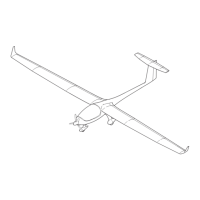FLIGHT MANUAL TSA-M, VARIANT S6
Doc.-No.: P400-006.000 E Page: 7-27 Revision: ---
Date of Issue: 07. October 2008 Date of Rev.: --.--.----
7.11.6 Engine-Cooling-System
The heat dissipation of the liquid-cooling-system for the cylinder-heads occurs in
a aluminum-gill-radiator. An oil-cooler for the lubrication-circuit is placed below
the aluminum-gill-radiator. Both coolers are placed below the engine and are
supplied with ram-air from the central NACA-inlet between the main-landing-
gear-legs on the bottom of the fuselage.
The ram-air for cooling the cylinders is inducted through an inlet which is located
to the right of the water-cooler. It then is lead through a hose and an air-
distributor made of glass-fiber-composites (GFC) to the cylinders.
The used cooling-air is discharged through two outlets. The first is an adjustable
gill-outlet on the lower side of the fuselage, whereas the second is the outlet of
the exhaust-gas-system on top of the fuselage between the wings.
Depending on the value of the operating-temperature of the engine, the position
of the gill-outlet and of the cowl-flaps can be adjusted with a bowden-cable.
Operation of the cowl-flaps:
The cowl-flaps of the inlets and outlets are manually operated with a self-locking
black T-handle at the center-console below the instrument-panel.
If the handle is positioned fully forward this causes the cowl-flaps to be fully
OPEN. When pulling on the handle, the flaps can be closed up to a minimum
position. To pull the cowl-flap-handle, it needs to be unlocked by pushing an
unlock-button. Lock the cowl-flap-handle in the desired position by simply
releasing the unlock-button.
If the engine is cold or when in the glider-configuration (engine not running),
keep the inlets and outlets closed. This minimizes the warm-up-time for the
running engine or reduces the aerodynamic drag in the glider-configuration.
Note: The cooling-system is very powerful. Because of this, it needs to
be regulated in all phases of the flight (T/O, cruise, and others)!

